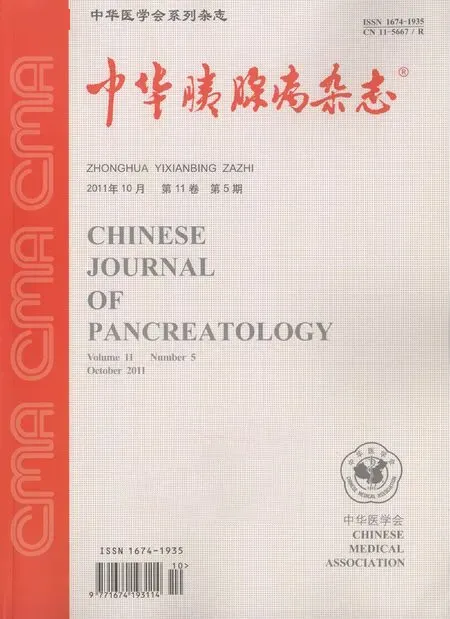晚期糖基化終末產物受體在急性壞死性胰腺炎大鼠中的表達
蘇曉菊 汪鵬 滿曉華 蔣斐 杜奕奇 鄭永志 金晶 龔燕芳 高軍 湛先保 李兆申 鄒多武
·論著·
晚期糖基化終末產物受體在急性壞死性胰腺炎大鼠中的表達
蘇曉菊 汪鵬 滿曉華 蔣斐 杜奕奇 鄭永志 金晶 龔燕芳 高軍 湛先保 李兆申 鄒多武
目的觀察急性壞死性胰腺炎(ANP)大鼠發病過程中胰腺組織及血清中晚期糖基化終末產物受體(the receptor for advanced glycation end products, RAGE)含量變化的規律。方法64只雄性SD大鼠按完全隨機法分為對照組,ANP 6、18、24、36、48、72、96 h組,每組8只。采用腹腔注射20% L-精氨酸250 mg/100 g體重2次、間隔1 h方法制備ANP模型。對照組大鼠腹腔注射等容積生理鹽水。胰腺組織行病理學檢查并評分。檢測腹水量、血清淀粉酶及RAGE濃度,實時PCR法檢測胰腺組織RAGE mRNA表達。結果ANP組胰腺病理損傷隨時間延長逐漸加重;腹水量從6 h的(1.98±0.64)ml增加到96 h的(8.69±0.62)ml;血清淀粉酶濃度從造模后6 h開始升高,18 h達(5069.88±603.25)U/L,36 h時恢復正常。對照組大鼠血清RAGE濃度及胰腺組織RAGE mRNA表達量分別為(18.33±2.99)ng/ml和0.41±0.13。ANP組6 h時兩者開始升高,分別為(30.31±5.03)ng/ml和1.57±0.19,較對照組顯著升高(P<0.05);24 h組達峰值,分別為(105.41±21.31)ng/ml和4.23±0.73,較ANP其他時間點顯著升高(P值均<0.05);96 h下降至最低點,分別為(33.54±6.96)ng/ml和1.19±0.19,但仍高于對照組(P<0.05)。結論血清RAGE濃度及胰腺組織RAGE mRNA表達量在ANP發生36 h內逐漸增加,隨后下降,但始終高于正常值。
胰腺炎,急性壞死性; 受體,晚期糖基化終產物; 胰腺組織; 炎癥; 精氨酸; 大鼠
晚期糖基化終末產物受體(RAGE)屬于細胞表面分子免疫球蛋白超家族多配體受體成員[1],廣泛分布在單核-巨噬細胞、內皮細胞、平滑肌細胞、腎小球系膜細胞、腫瘤細胞、星形膠質細胞、T淋巴細胞等表面[2],可以與HMGB1、S100/鈣結合蛋白,淀粉樣肽等多種配體結合[3-4],激活多條細胞內信號轉導途徑,活化NF-κB[5],參與炎癥反應過程。目前有研究提示,重癥急性胰腺炎(SAP)合并器官衰竭時血清中RAGE水平顯著升高。本實驗觀察急性壞死性胰腺炎(ANP)大鼠胰腺組織RAGE mRNA及血清RAGE濃度的動態變化,探討RAGE的變化規律。
材料與方法
一、實驗動物與分組
健康雄性SD大鼠,體重200~250 g,5~6周齡,清潔級,第二軍醫大學實驗動物中心提供,動物合格證號:SCXK(滬)2007-0003。適應性喂養1周后按完全隨機法分為對照組,ANP 6、18、24、36、 48、72、96 h組,每組8只。參照Tani等[6]方法,采用腹腔注射20% L-精氨酸(Sigma公司)250 mg/100 g體重2次、間隔1 h制備ANP模型。對照組大鼠腹腔注射等容積生理鹽水。按各時間點處死大鼠,心臟取血,抽取腹水,留取胰腺組織。部分胰腺組織置液氮保存,部分置4%中性甲醛液固定。
二、觀測指標及檢測方法
1.血清淀粉酶、腹水量檢測: 血清淀粉酶采用HITACHI-7150型自動生化分析儀測定,腹水量應用10 ml針筒抽吸測量。
2.胰腺組織病理學檢查: 固定的胰腺組織常規石蠟包埋、切片、HE染色,采用盲法由病理科醫師閱片,參照Rongione標準[7]進行評分。
3.血清RAGE濃度檢測:采用RAGE 酶聯免疫吸附法(ELISA)試劑盒 (上海威奧生物技術有限公司)檢測,嚴格按照試劑盒說明書操作。
4.胰腺組織RAGE mRNA檢測:采用實時PCR法。用Trizol試劑盒(上海晶美公司)提取胰腺組織總RNA。應用Primer5.0軟件設計引物,RAGE引物:上游5′-AACACAGGAAGGACTGAAGC-3′,下游5′-AGACTCGGACTCGGTAGTTG-3′,片段長度190 bp;β-actin(內參)引物:上游5′-CCTGTACGCCAACAC-AGTGC-3′,下游5′-ATACTCCTGCTTGCTGATCC-3′,片段長度 251 bp。引物由上海英駿生物技術公司合成。逆轉錄cDNA后,使用 SYBR Premix Ex TagTM試劑盒,在ABI 7500PCR儀(Applied Biosystems公司)上采用兩步法PCR擴增標準程序進行基因擴增。熒光定量PCR的結果以Ct值顯示。以正常胰腺組織作為對照,△△Ct=△Ct樣品-△Ct正常胰腺=(Ct樣品-Ct內參)-(Ct正常胰腺-Ct內參),RQ=2-△△Ct。
三、統計學處理

結 果
一、血清淀粉酶、腹水量的變化
造模后6 h起,血清淀粉酶水平開始升高,18 h達峰值,以后下降,36 h恢復到正常值。腹水量隨著時間推移逐漸增多,96 h達峰值(表1)。
二、大鼠胰腺組織病理改變
對照組胰腺未見明顯損傷。ANP 6 h組胰腺組織出現間質水腫,有輕、中度炎細胞浸潤;18 h組有大量炎細胞浸潤,輕度實質壞死和出血;36 h組腺泡結構破壞較多,小葉排列紊亂,其間充斥大量炎性滲出;72 h組胰腺壞死加重,可見皂化斑;96 h組胰腺組織壞死最嚴重(圖1)。ANP 6、18、24、36、48、72、96 h組胰腺組織病理分值分別為(3.38±1.30)、(6.88±0.64)、(9.50±1.77)、(10.25±1.04)、(12.00±1.31)、(12.38±1.06)、(13.50±0.93)分,均較對照組的(0.38±0.52)分顯著升高(P值均<0.05)。
三、血清RAGE濃度的變化
ANP各組血清RAGE濃度均顯著高于對照組(P值均<0.05),其中24 h組最高(表1)。
四、胰腺組織RAGE mRNA表達的變化
ANP各組胰腺組織RAGE mRNA表達量均顯著高于對照組(P值均<0.05),其中24 h組的表達量最高(表1)。胰腺組織RAGE mRNA表達量與血清RAGE濃度變化的趨勢完全一致(圖2)。

表1 各組大鼠腹水量、血清淀粉酶及RAGE濃度、胰腺組織RAGE mRNA表達量的變化
注:與對照組比較,aP<0.05;與ANP 24 h組比較,bP<0.05

圖1 對照組(a),ANP 6(b)、18(c)、24(d)、36(e)、48(f)、72(g)、 96 h(h)組胰腺組織病理改變(HE ×200)

圖2胰腺組織RAGE mRNA表達量與血清中RAGE濃度的變化趨勢
討 論
晚期糖基化終末產物受體(RAGE)最初在牛肺內皮細胞中發現,能結合多種配體[3-4]。它屬于單跨膜片段受體,由400多個氨基酸組成,分為胞外段、跨膜段和胞內段,相對分子質量約25 000。其胞外段包含3個免疫球蛋白樣結構(1個V區和2個C區),V區是RAGE胞外段與配體結合的主要位點,其后是疏水的跨膜段,最后是高度帶電荷的胞內段[8]。在個體生長發育階段,RAGE高水平表達于內皮細胞、單核巨噬細胞、外膜細胞、腎系膜細胞、平滑肌細胞的胞膜,尤其在心肌細胞、中樞神經系統表達豐富。在成熟的動物及人體中RAGE呈低水平表達。當細胞處于激活或應激狀態時,細胞的RAGE表達急劇增加。
文獻報道,吸煙相關性氣道疾病、肉芽腫性炎癥、間質性肺炎等幾種持續性炎癥性肺病患者的肺組織RAGE表達增強[9],晚期腎臟疾病和急性肺損傷患者血清RAGE水平升高[10-11]。Mullins等[12]報道,嚴重膿毒癥或膿毒癥休克患者入院時血清中RAGE濃度升高,但大多數患者在入院后96 h恢復至基線水平。
本結果顯示,ANP組大鼠血清RAGE濃度及胰腺組織RAGE mRNA表達均較對照組明顯增加,均在24 h時達峰值,此后逐漸下降,96 h時最低,但仍高于對照組,表明RAGE在ANP的病程中并不是線性增高的。但ANP大鼠的胰腺組織病理損傷隨時間推移進行性加重,推測RAGE參與早期的炎癥反應,還有其他炎癥因子參與整個疾病過程。
[1] Wilson PG, Manji M, Neoptolemos JP. Acute pancreatitis as a model of sepsis. J Antimicrob Chemother, 1998, 41:51-63.
[2] Ulloa L, Tracey KJ. The cytokine profile: a code for sepsis.Trends Mol Med, 2005, 11:56-63.
[3] Goodwin GH, Shooter KV, Johns EW. Interaction of a non-histone chromatin protein (high-mobility group protein 2) with DNA. Eur J Biochem, 1975, 54:427-433.
[4] Melvin VS, Edwards DP. Coregulatory proteins in steroid hormone receptor action: the role of chromatin high mobility group proteins HMG-1 and -2. Steroids, 1999, 64:576-586.
[5] Bustin M. Regulation of DNA-dependent activities by functional motifs of the high-mobility-group chromosomal proteins. Mol Cell Biol, 1999, 19:5237-5246.
[6] Tani S, Itoh H, Okabayashi Y, et al. New modeI of acute necrotizing pancreatitis induced by excessive doses of arginine in rats. Dig Dis Sci, 1990, 35:367-374.
[7] Rongione AJ, Kusske AM, Ashley SW, et al. Interleukin 10 reduces the severity of acute pancreatitis in rats. Gastroenterology, 1997, 112:960-967.
[8] Bicdlaus A, Hofmann MA, Ziegler R, et al. AGE and their interaction with AGE reception in vacular disease and diabetes mellitmi. Cardiovase Res, 1998, 37:586-600.
[9] Harashima A, Yamamoto Y, Cheng C, et al. Identification of mouse orthologue of endogenous secretory receptor for advanced glycation end-products: structure, function and expression. Biochem J, 2006, 396:109-115.
[10] Kalousova M, Jachymova M, Mestek O, et al. Receptor for advanced glycation end productsVsoluble form and gene polymorphisms in chronic haemodialysis patients. Nephrol Dial Transplant, 2007, 22:2020-2026.
[11] Uchida T, Shirasawa M, Ware LB, et al. Receptor for advanced glycation end-products is a marker of type I cell injury in acute lung injury. Am J Respir Crit Care Med, 2006, 173:1008-1015.
[12] Mullins G, Sunden-Cullberg J, Tokics L, et al. Increase of Soluble RAGE in Patients With Severe Sepsis/Septic Shock [PhD thesis]. Stockholm, Sweden: Karolinska University, Department of Medicine, 2005.
2011-05-25)
(本文編輯:呂芳萍)
Expressionofreceptorforadvancedglycationendproductsinratswithacutenecrotizingpancreatitis
SUXiao-ju,WANGPeng,MANXiao-hua,JIANGFei,DUYi-qi,ZHENGYong-zhi,JINJing,GONGYan-fang,GAOJun,ZHANXian-bao,LIZhao-shen,ZOUDuo-wu.
DepartmentofGastroenterology,ChanghaiHospital,SecondMilitaryMedicalUniversity,Shanghai200433,China
ZOUDou-wu,Email:dwzou@smmu.edu.cn
ObjectivesTo explore the expression of the receptor for advanced glycation end products (RAGE) in pancreas and the serum concentration of RAGE in rats with acute necrotizing pancreatitis (ANP).MethodsSixty four male Spraque-Dawley rats were randomly divided into control group, ANP 6, 18, 24, 36, 48, 72, 96 h group with 8 rats in each group.The rat model of ANP was established by injecting 20% L-arginine intraperitoneally at the dose of 250mg/100g body weight for twice at the interval of 1 h. Rats in control group were injected intraperitoneally with the same amount of saline. The pancreas samples were histologically examined by light microscope and scored. The amount of ascites, levels of serum amylase and RAGE was determined; Real-time PCR was performed to detect the expression of RAGE mRNA in pancreatic tissue.ResultsPancreatic injuries aggravated with time. The amount of ascites increased from (1.98±0.64)ml at 6h to (8.69±0.62)ml at 96 h. Serum amylase level began to increase at 6h after L-arginine intraperitoneal injection and reached the peak value at 18 h [(5069.88±603.25)U/L], and returned to normal at 36 h. The serum concentration of RAGE and RAGE mRNA expression in pancreatic tissue were (18.33±2.99)ng/ml and 0.41±0.13 in the control group. The corresponding values increased at 6 h in ANP group, which were (30.31±5.03)ng/ml and 1.57±0.19, and they were significantly higher than those in the control group (P<0.05); they reached the peak value at 24 h [(105.41±21.31)ng/ml and 4.23±0.73], which were significantly higher than those in other ANP groups (P<0.05); at 96 h they decreased to the lowest point [(33.54±6.96)ng/ml and 1.19±0.19], which were still significantly higher than those in the control group (P<0.05).ConclusionsThe expression levels of RAGE in pancreatic tissues and serum level of RAGE increase within 36 h of ANP onset,then decrease gradually, but they are always higher than normal values.
Pancreatitis, acute necrotizing; Receptor, advanced glycation end products; Pancreatic tissue; Inflammation; Arginine; Rat
10.3760/cma.j.issn.1674-1935.2011.05.009
200433 上海,第二軍醫大學長海醫院消化內科
鄒多武,Email: dwzou@smmu.edu.cn

